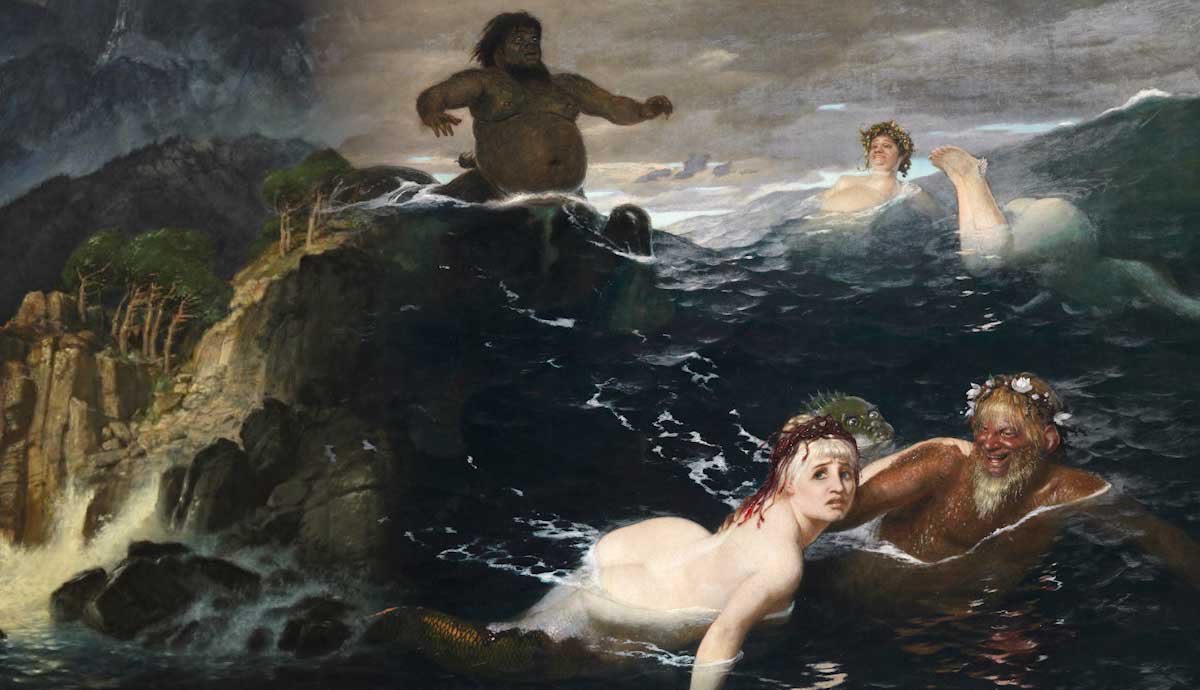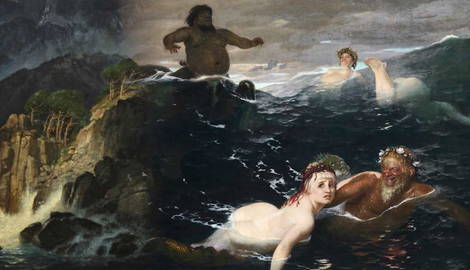
Arnold Böcklin’s artworks are considered the paradigmatic works of German Symbolism, which earned the artist a cult following in the German-speaking world of the 19th century. The writer Max Halbe mentions that between 1885 and 1890, almost all of the upper-class homes in Germany had a copy of the Isle of the Dead or Villa at the Sea by Böcklin. The mass consumption of his imagery confirms the contemporary opinion that Böcklin was held above his colleagues in the mind of the public. Arnold Böcklin’s artworks, as well as his personality, influenced younger Symbolist artists in Germany and Europe. The painting Isle of the Dead held a canonic status beyond the boundaries of German-speaking territories, contributing to Böcklin’s international fame. Here are 10 of his most notable artworks.
1. Isle of the Dead, 1880-1886

Isle of the Dead is Arnold Böcklin’s most famous artwork, both during his life and today. Böcklin made five versions of this eerie painting between 1880 and 1886.
The imaginary island of the southern hemisphere revives the ancient motif of island burial. The standing figure of the deceased in white and the boatman are the focus of the painting, which is a mysterious symbol meant to steer hidden desires and unsaid longings. As with many of the landscapes among Arnold Böcklin’s artworks, this is not a real place but a painted or visualized mood.
Arnold Böcklin’s artworks are a subjective synthesis of the interior and exterior world. They are edited notions of memories the artist had. Meaning to represent the soul, Böcklin was memorizing his observations of nature and materializing them on his canvases. The Isle of the Dead is described by Böcklin as: “You will be able to dreamingly dive into the dark world of shadows.”
2. Self-Portrait with Death Playing the Fiddle, 1872

Arnold Böcklin created his most famous self-portrait in Munich in 1872. The theme is the antithetical relationship between life and death and the meaning of this relationship for the artist. Though it seems melancholic, the composition speaks of a heightened awareness of life. From his earliest years, exploration of death as a metaphor permeated Arnold Böcklin’s artworks. His hometown of Basel boasted itself on many variations of the Dance of Death, which may have inspired the artist.
In the Self-Portrait with Death Playing the Fiddle, the artist is listening intently to Death’s tune, transforming this vision into a metaphor for artistic inspiration. In keeping with the sensibilities of the time, artistic inspiration was linked to the idea of borderline experiences. The hand holding the brush and the palette are the base from which the composition rises in a pyramid culminating in the artist’s head. The active Death is simultaneously a painted attribute, the work of the artist. The significance of this work is seen in its versions done by other 19th-century German artists, Hans Thoma, Lovis Corinth, and Oskar Zwintscher.
3. Playing in the Waves, 1883

Painted in 1883, Playing in the Waves was met with mixed reception from art critics, but the enthusiasm for Arnold Böcklin’s artwork grew quickly. By the time of the Third Munich International exhibition in 1888 and certainly in 1899, the craze for Arnold Böcklin’s work was in full swing. The art historian Cornelius Gurlitt (the brother of Böcklin’s Berlin dealer Fritz Gurlitt) wrote that the German public regarded this painting as “one of the greatest achievements of our century.”
Unlike the big part of his opus, the painting recalls an everyday incident witnessed by Böcklin during a holiday on the Italian coast. His friend, the zoologist Anton Dohrn, surprised a group of women bathers, approaching them underwater and suddenly resurfacing. Despite this more comedic take on Greek mythology, the image is not simply playful. The color palette is dark and melancholic, and the fear on the woman’s face seems real enough. We, as the viewer, are thus confronted with a strange mixture of sensual, frightful, and humorous energy.
4. Venus Anadyomene, 1872

Shortly after arriving in Munich, Böcklin began to work on a new version of The Birth of Venus in 1872. The previous version he worked on in Basel was cast aside, partly as a reaction to criticism of the cultural historian and friend Joachim Burckhardt. The scholar, who was familiar with Greco-Roman and Renaissance culture, objected to the lack of dolphins and large waves typical for the scene of the birth of Venus.
This version, titled Venus Anadyomene, included a dolphin, but one that was far from what Burckhardt envisioned. The sea monster is perhaps a reference to contemporary Darwinian debates in Europe. Venus herself contradicts the traditional iconography of the classical theme. According to the myth, she emerged from the foam of the waves or from a mussel shell. Cupids, another traditional part of the scene, with butterfly wings, clothe her in sea foam and crown her with a wreath.
5. Villa by the Sea, 1865

Arnold Böcklin conceived this composition in 1863, soon after his return to Rome, following a difficult period working in the North. The painting was originally commissioned by Arnold Böcklin’s great supporter Count Schack and became widely popular. In total, the artist produced five versions of the painting. Its success encouraged Böcklin to go on to produce similar intensive landscapes, like the Isle of the Dead and Chained Prometheus.
The setting of the scene is classical, but it evokes a mood of longing that reminds of the northern romantic landscape painting tradition. This was a tradition Böcklin had absorbed while studying at the Düsseldorf Academy. The earliest sketch of the composition shows a couple leaning on a wall in a gentle evening reverie. This later version, like all the others, has a more tragic and lonely aspect, with a single shrouded woman looking out to sea. There is a sense of foreboding, intensified by the wind that blows through the poplars above the villa.
6. Chained Prometheus, 1885

The theme of the painting is the Titan Prometheus from Greek mythology, who stole fire from the gods and gave it to man. He was punished for this by Zeus, who had him chained down to a rock, where an eagle came daily to feed off his liver. He was eventually released from this imprisonment by Hercules.
During the 19th century, Prometheus came to be seen as a symbol of freedom, a champion of mankind against tyranny. He also became a prototype of the artist, who received the fire of creative inspiration from the heavens. The image of Prometheus played a key role in the formation of the thought of Karl Marx and Friedrich Nietzsche, who both saw themselves as Prometheus-like figures, stealing new insights from the powers to inspire mankind to rebellion or self-awareness.
Arnold Böcklin modeled his own Prometheus based on a classical wall painting of Tityus, a giant in Greek mythology who suffered a similar fate. The artist gave an original interpretation of the theme by envisaging Prometheus in terms of a doom-laded atmospheric landscape. One of Böcklin’s daughters claimed that the setting was inspired by the view of the clouds on the hills of Monte Morello above Fiesole.
7. Battle of the Centaurs, 1873

One of the most common motifs and creatures from Arnold Böcklin’s bestiary is the half-horse, half-man, centaur. The Battle of the Centaurs, completed in Munich, was widely exhibited and quickly gained popularity in the German-speaking world. The painting is an homage to Michelangelo’s unfinished 1492 marble relief Battle of the Centaurs, reworking the classical mythical trope of Renaissance art.
The grandeur of the theme and mood spoke to the German nationalism of the late 19th century. More importantly, it reflects the idea of a centaur as the expression of the dual nature of mankind. It shows humanity’s animal impulses and the spirit that drives it forward.
Centaurs in Arnold Böcklin’s artworks are massive, engaged in battle, seething and spitting with fury, with eyeballs bulging with rage. The contemporary description of the painting goes:
“…evidently in an era when the elemental forces still struggled wildly with one another and the earth was still held in continuous transformation by the forces of fire and water, we see living creatures of this terrible stormy period of our planet’s youth who stand in amazing conformance with the Creation emerging from this Chaos.”
8. Diana’s Hunt, 1896

Arnold Böcklin’s artworks continually returned to mythological subjects. With this painting, dated to 1896, Böcklin returned to a subject he had painted early in his career for the museum in his native city of Basel. Therefore, this work refers to his youth but is also an homage by an aging artist to the great tradition of classical landscape painting.
The inspiration for this work was a part of Ovid’s Metamorphoses. The episode recalls how the hero Actaeon becomes lost during a hunt, bumping into and surprising the goddess Diana as she bathes nude in a pool of water. The goddess, outraged, transformed him into a stag, and he is hunted down and eaten by his own dogs.
Böcklin decided to paint Diana armed with her bow, accompanied by several hunters and dogs, chasing after a wounded stag. They are set in an almost supernatural landscape in which some details have been treated with great precision.
9. Idyll (Pan Among Columns), 1875

The lascivious pagan Greek god Pan is one of the most repetitive motifs in Arnold Böcklin’s artworks. Appearing among the overgrown and vine-wreathed columns of a ruined temple, Pan disturbs the idyllic calm of a summer’s day in the country with his melancholic music. He plays on an eight-stem reed pipe, named after the Arcadian Nymph Syrinx, who was saved in her flight from his lustful advances through her transformation into a reed. In order to console himself for his disappointment in love, Pan made a reed pipe out of the plant. In his visual depictions, the instrument has served as Pan’s attribute.
The principal elements of the composition are treated as the pieces of a stage set. Pan peers out at the spectator across the intervening swamp and its plant life. He is stripped away from his mythological embodiment of the powers of nature and assumes a somewhat humorous quality.
10. A Tavern in Ancient Rome, 1867

During his first stay in Rome from 1850 to 1857, Arnold Böcklin attended a festival of dance that inspired this painting. In it, he freely combines observed topographical details with elements that were pure invention. On the right, we find one of the taverns located at the Porta del Popolo, an important meeting place for German painters in Rome in the 19th century. On the left is a small round structure reminiscent of Vignola’s temple of Sant’ Andrea. Walking towards it is a young woman led by a Cupid. A holy man dressed in a long white robe accompanied by a naked youth has already reached the place of worship. In contrast to them are the dancing and singing figures, who symbolize unbridled lust. The dichotomy recalls the Apollonian and Dionysian principles of Friedrich Nietzsche (with whom the artist was acquainted). Arnold Böcklin’s artwork combines elements from a contemporary genre scene with a pagan festival in honor of Bacchus/Dionysius as celebrated in Antiquity.










